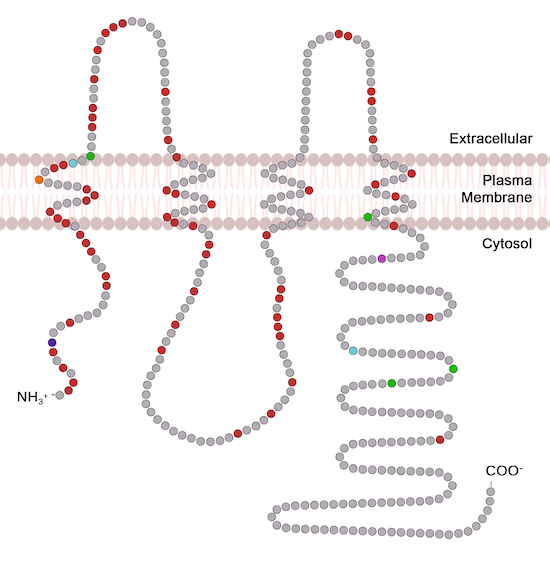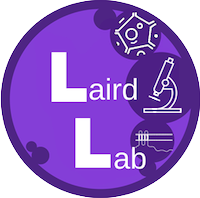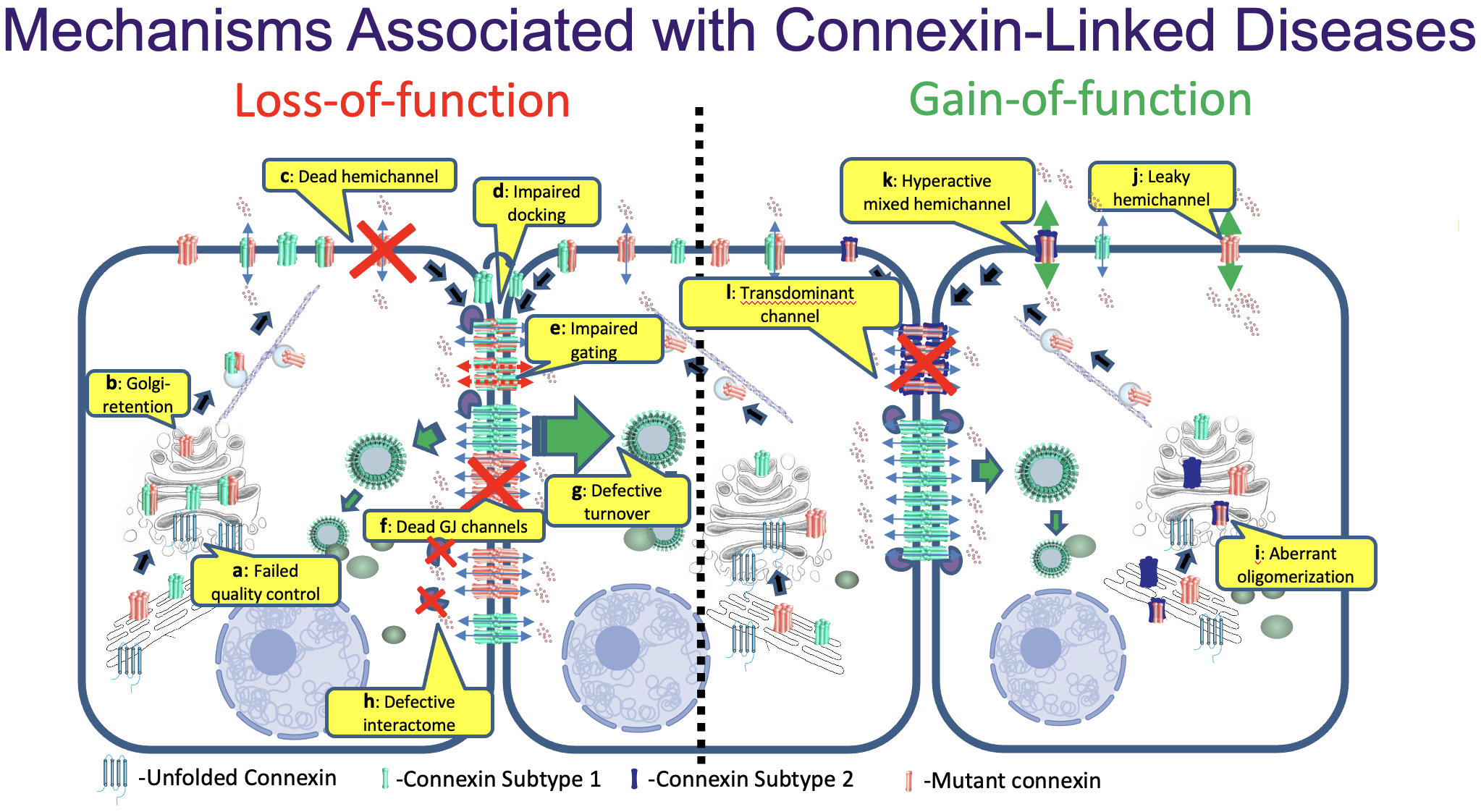Research
Contact Info
Dr. Dale W. Laird
Anatomy and Cell Biology
Western University
Dental Sci Bldg, Rm 00077
London, ON, Canada N6A 5C1
t. 519.661.2111, ext. 86827
dale.laird@schulich.uwo.ca
Modeling Connexin-Linked Diseases
Connexin-linked diseases range from being common to very rare and are collectively amongst the most common inherited diseases/syndromes worldwide estimated to affect over 2 million patients. Our laboratory is particularly interested in examining Cx26, Cx30 and Cx43 gene mutations that lead to hearing loss, various skin diseases and oculodentodigital dysplasia (ODDD). Interestingly, several loss- or gain-of-function mutations in Cx26 have been identified that result in only hearing loss while others exhibit trans-dominant effects on other connexins resulting in both hearing loss and various forms of human skin disease. In our laboratory, mutant connexins are expressed and characterized in well-understood cell lines and in tissue-relevant cells capable of undergoing differentiation.
 Our research program is particularly interested in determining the mechanisms underpinning ODDD. ODDD is primarily an autosomal-dominant human disorder where patients commonly display symptoms of congenital craniofacial deformities, ocular defects, enamel loss and fused digits. To date, over eighty known Cx43 gene mutations are linked to ODDD, with the majority clustered in the N-terminal two-thirds of the Cx43 polypeptide sequence. The consequences of these mutations on Cx43 function are being investigated in reference cell systems and organotypic models such as the epidermis. In the past, these studies have been complemented with genetically-modified mouse models that harbour Cx43 mutants and mimic the human ODDD disease. We have also established several bench-to-bedside studies involving patient samples obtained from around the world. This approach has led to the establishment of a small repository of ODDD patient samples and established cell lines that can be further used to explore the etiology of ODDD. Once mechanistic information is known about how mutant connexins cause disease and developmental abnormalities, long-term goals include developing strategies to compensate for cellular defects caused by these mutants.
Our research program is particularly interested in determining the mechanisms underpinning ODDD. ODDD is primarily an autosomal-dominant human disorder where patients commonly display symptoms of congenital craniofacial deformities, ocular defects, enamel loss and fused digits. To date, over eighty known Cx43 gene mutations are linked to ODDD, with the majority clustered in the N-terminal two-thirds of the Cx43 polypeptide sequence. The consequences of these mutations on Cx43 function are being investigated in reference cell systems and organotypic models such as the epidermis. In the past, these studies have been complemented with genetically-modified mouse models that harbour Cx43 mutants and mimic the human ODDD disease. We have also established several bench-to-bedside studies involving patient samples obtained from around the world. This approach has led to the establishment of a small repository of ODDD patient samples and established cell lines that can be further used to explore the etiology of ODDD. Once mechanistic information is known about how mutant connexins cause disease and developmental abnormalities, long-term goals include developing strategies to compensate for cellular defects caused by these mutants.
We are particularly interested in connexin gene mutations that lead to a skin disease known as erythrokeratodermia variabilis et progressive (EKVP). EKVP is somewhat unusual in that mutations in any one of three connexin genes can lead to this disease. Mechanistic studies have already shown that upwards of 5 molecular mechanisms may be at the root of this disease. Our long-term goal is to determine which mutants might be amenable to therapeutic interventions.
Selected Publications
S.A. Lucaciu, Q. Shao, R. Figliuzzi, K. Barr, D. Bai and D.W. Laird (2022) “Interrogation of carboxy-terminus localized GJA1 variants associated with erythrokeratodermia variabilis et progressiva” International Journal of Molecular Sciences 23: 486, doi: 10.3390/ijms23010486.
D.W. Laird and P.D. Lampe (2022) “Cellular mechanisms of connexin-based inherited diseases” Trends in Cell Biology 32: 58-69.
E. Jewlal, K. Barr, D.W. Laird and K.E. Willmore (2021) “Connexin 43 contributes to phenotypic robustness of the mouse skull” Developmental Dynamics 250: 1810-1827.
N. Novielli-Kuntz, E. Press, K. Barr, M.A.M. Prado and D.W. Laird (2021) “Mutant Cx30-A88V mice exhibit hydrocephaly and sex-dependent behavioural abnormalities, implicating a functional role for Cx30 in the brain” Disease Models & Mechanisms 14(1): dmm046235. doi: 10.1242/dmm.046235
E.C. Bedoukian, S. Rentas, C. Skraban, Q. Shao, J. Treat, D.W. Laird and K.E. Sullivan (2021) “Palmoplantar keratoderma with deafness phenotypic variability in a patient with an inherited GJB2 frameshift variant and novel missense variant” Molecular Genetics & Genomic Medicine : e1574. doi: 10.1002/mgg3.1574. Online ahead of print. PMID: 33443819
A.C. Moore, J. Wu, E. Jewlal, K. Barr, D.W. Laird and K.W. Willmore (2020) “Effects of reduced connexin43 function on mandibular morphology and osteogenesis in mutant mice models of oculodentodigital dysplasia” Calcified Tissue International 107: 611-624.
J.L Esseltine, C.R. Brooks, N.A. Edwards, M. Subasri, J. Sampson, C. Seguin, D.H. Betts and D.W. Laird (2020) “Dynamic regulation of connexins in stem cell pluripotency” Stem Cell 38: 52-66.
Q. Shao, J.L. Esseltine, T. Huang, N. Novielli-Kuntz, J.E. Ching and J. Sampson and D.W. Laird (2019) “Connexin43 is dispensable for early stage human mesenchymal stem cell adipogenic differentiation but is protective against cell senescence” Biomolecules 11: 474.
D.W. Laird and P.D. Lampe (2018) "Therapeutic strategies targeting connexins" Nature Reviews Drug Discovery doi:10.1038/nrd.2018.138 [Epub ahead of print]. (Highlighted by Schulich Media and in The Collaborator).
D.W. Laird, C.C Naus and P.D. Lampe (2017) "Snapshot: Connexins and Disease" Cell 170: 1260-1260.
E. Press, K.C. Alaga, K. Barr, Q. Shao, F. Bosen, K. Willecke and D.W. Laird (2017) "Disease-linked connexin26 S17F promotes volar skin abnormalities and mild wound healing defects in mice" Cell Death and Disease 8: e2845.
E.R. Press, Q. Shao, J.J. Kelly, K. Chin, A. Alaga and D.W. Laird (2017) "Induction of cell death and gain-of-function properties of connexin26 mutants predicts severity of skin disorders and hearing loss" Journal of Biological Chemistry 292: 9721-9732.
J.L. Esseltine, Q. Shao, C. Brooks, J. Sampson, D.H. Betts, C.A. Séguin and D.W. Laird (2017) "Connexin43 Mutant Patient-Derived Induced Pluripotent Stem Cells Exhibit Altered Differentiation Potential." Journal of Bone and Mineral Research 32: 1368-1385.
J.J. Kelly, J. Esseltine, Q. Shao, E.W. Jabs, J. Sampson, M. Auranen, D. Bai and D.W. Laird (2016) “Specific functional pathologies of Cx43 mutations associated with oculodentodigital dysplasia” Molecular Biology of the Cell 27: 2172-2185.
J.L. Esseltine, Q. Shao, T. Huang, J.J. Kelly, J. Sampson and D.W. Laird (2015) “Manipulating Cx43 expression triggers gene reprogramming events in dermal fibroblasts from oculodentodigital dysplasia patients” Biochemical Journal 472: 55-69.
M.K.G. Stewart, J. Simek and D.W. Laird (2015) “Insights into the role of connexins in mammary gland morphogenesis and function” Reproduction 149: R279-R290.
J.J. Kelly, J. Simek and D.W. Laird (2015) “Mechanisms linking connexin mutations to human diseases” Cell and Tissue Research 360: 701-721.
D.W. Laird (2014) “Syndromic and non-syndromic disease-linked Cx43 mutations” FEBS Letters 588: 1339-1348.
M.K.G. Stewart, I. Plante, J.F. Bechberger, C.C. Naus and D.W. Laird (2014) “Mammary gland specific knockdown of the physiological surge in Cx26 during lactation retains normal mammary gland development and function” PLOS One 9(7): e101546.
T. Huang, Q. Shao, K. Barr, G.I. Fishman and D.W. Laird (2014) “Myogenic bladder defects in mouse models of human oculodentodigital dysplasia” Biochemical Journal 457: 441-449.
Y. Sun, X. Tong, H. Chen, T. Huang, Q. Shao, W. Huang, D.W. Laird and D. Bai (2014) “An endoplasmic reticulum-retained atrial fibrillation-linked connexin40 mutant impairs atrial gap junction channel function” Disease Models and Mechanisms 7: 561-569.
J.M. Churko and D.W. Laird (2013) “Gap junction remodeling in skin repair following wounding and disease” Physiology 28: 190-198.
T. Huang, Q. Shao, A. MacDonald, L. Xin, R. Lorentz, D. Bai and D.W. Laird (2013) “Autosomal recessive GJA1 (Cx43) gene mutations cause oculodentodigital dysplasia by distinct mechanisms” Journal of Cell Science 126: 2857-2866.
M.K.G. Stewart, X.-Q, Gong, K.J. Barr, D. Bai, G.I. Fishman and D.W. Laird (2013) “Mammary gland defects as revealed by genetically-modified mice harboring an oculodentodigital dysplasia-linked Cx43 mutant” Biochemical Journal 449: 401-213.
J.M. Churko, J. Kelly, A. McDonald, J. Lee, J. Sampson, D. Bai, and D.W. Laird (2012) “Mutant Cx43 enhances keratinocyte proliferation without impacting keratinocyte migration” Experimental Dermatology 21: 612-618. *Image selected for the cover.
J.M. Churko, Q. Shao, X-Q Gong, K. Swoboda, D. Bai, J. Sampson, D.W. Laird (2011) “Human dermal fibroblasts derived from oculodentodigital dysplasia patients suggest that patients have wound healing defects” Human Mutation 32: 456-466.
J.M. Churko, J. Chan, Q. Shao and D.W. Laird (2011) “The G60S connexin43 mutant regulates hair growth and hair fiber morphology in a mouse model of human oculodentodigital dysplasia” Journal of Investigative Dermatology 131: 2197-2204.
J.M. Churko, S. Langlois, X. Pan, Q. Shao and D.W. Laird (2010) “The potency of the fs260 Cx43 mutant to impair keratinocyte differentiation is distinct from other disease-linked Cx43 mutants” Biochemical Journal 429: 473-483.










